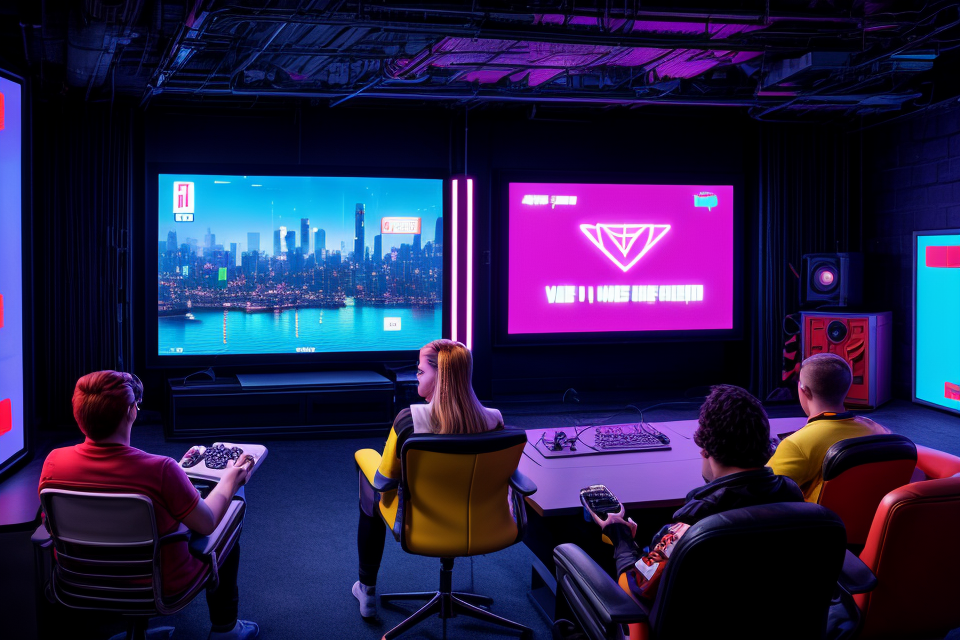The world of video games has come a long way since its inception. With the latest releases promising mind-blowing graphics, realistic gameplay, and immersive storylines, it’s hard to imagine a time when gaming was in its infancy. But, what was the actual first video game? The answer might surprise you, as the history of video games is not as straightforward as one might think. In this article, we’ll delve into the origins of the gaming industry and unpack the fascinating story of the first video game. Join us as we take a trip down memory lane and explore the game that started it all.
The Evolution of Video Games
Early Arcade Machines
The Creation of Coin-Operated Games
The early arcade machines were coin-operated games that were designed to entertain crowds in public places such as amusement arcades, bowling alleys, and movie theaters. These games were created in the late 1970s and were an instant hit, attracting people of all ages who were looking for a new form of entertainment.
Pong: The Beginning of the Video Game Revolution
Pong, developed by Atari in 1972, was one of the first and most popular arcade games. It was a simple game that involved a square ball bouncing around the screen, and two paddles controlled by the players that were used to hit the ball back and forth. Despite its simplicity, Pong was a major success and laid the foundation for the video game industry.
Other Early Arcade Hits
Other early arcade hits included Space Invaders, Asteroids, and Pac-Man. These games were also simple in concept but highly addictive, and they helped to establish the video game industry as a viable form of entertainment. They were also hugely successful commercially, and many of them remain popular to this day.
The Golden Age of Arcade Games
The golden age of arcade games began in the late 1970s and lasted until the mid-1980s. During this time, many classic arcade games were released, including Donkey Kong, Galaga, and Missile Command. These games were characterized by their simple graphics, addictive gameplay, and innovative use of technology.
Space Invaders and the Rise of Taito
Space Invaders, released in 1978, was one of the most popular arcade games of all time. It was created by the Japanese company Taito and was the first game to use the innovative concept of aliens attacking the player’s spaceship. The game was a huge success and helped to establish Taito as one of the leading video game companies in the world.
Asteroids and the Emergence of Atari
Asteroids, released in 1979, was another classic arcade game that helped to establish the video game industry. It was created by Atari and was one of the first games to use 3D graphics. The game was highly addictive and challenging, and it helped to establish Atari as one of the leading video game companies in the world.
The Decline of Arcade Games
The decline of arcade games began in the mid-1980s, due to a number of factors including the rise of home consoles, the emergence of new technologies, and changes in consumer preferences. The decline of arcade games had a significant impact on the gaming industry, leading to the closure of many arcade venues and the loss of many jobs.
The Home Console Era
The Birth of Home Consoles
The birth of home consoles can be traced back to the late 1960s and early 1970s, when companies like Magnavox and Ralph H. Baer began experimenting with video game technology. In 1972, Magnavox released the Odyssey, the first home console that could play video games. This groundbreaking device featured a series of simple games, including a version of table tennis that could be played by up to four players.
The Magnavox Odyssey and the Beginning of Home Gaming
The Magnavox Odyssey was a revolutionary device that paved the way for the home gaming industry. It was the first device that allowed families to play video games in the comfort of their own homes, marking the beginning of a new era in entertainment. The Odyssey’s simple games and basic graphics may seem primitive by today’s standards, but at the time, they were a marvel of technology that captured the imagination of gamers everywhere.
The Rise of Atari and the First Video Game Crash
The early 1980s saw the rise of Atari, a company that would come to dominate the home console market. Atari’s most popular console, the Atari 2600, was released in 1977 and quickly became a hit among gamers. The Atari 2600 boasted better graphics and more advanced games than the Odyssey, and its success helped to spur the growth of the home gaming industry. However, the industry’s rapid expansion would soon lead to a devastating crash that would change the course of video game history.
The Emergence of Nintendo and the NES
After the video game crash of 1983, the home console market lay dormant for several years. It wasn’t until the late 1980s that the industry began to rebound, thanks in part to the emergence of Nintendo and its wildly popular Nintendo Entertainment System (NES). The NES was a technological marvel that featured advanced graphics and a wide variety of games, including classics like Super Mario Bros. and The Legend of Zelda. The NES helped to revive the home console market and set the stage for the modern gaming landscape.
The Modern Gaming Landscape
The Current State of Home Consoles
Today’s home consoles, like the PlayStation 5 and Xbox Series X, are light-years ahead of their predecessors in terms of technology and capabilities. They boast stunning graphics, advanced AI, and online features that allow players to connect with each other from around the world. The modern home console market is highly competitive, with companies like Sony, Microsoft, and Nintendo vying for dominance.
The Rise of Mobile Gaming and Portable Devices
In recent years, mobile gaming has become a major force in the industry, with millions of people around the world playing games on their smartphones and tablets. Companies like Apple and Google have made it easier than ever to play games on mobile devices, and a wide variety of games are available for download from app stores. Portable gaming devices like the Nintendo Switch have also gained popularity, offering gamers the ability to play their favorite games on the go.
The Impact of Online Gaming and Cloud Gaming Services
Online gaming has transformed the industry by allowing players to connect with each other from around the world. Massive multiplayer online games like World of Warcraft and Fortnite have millions of active players, and cloud gaming services like Google Stadia and NVIDIA GeForce Now allow players to stream games directly to their devices without the need for expensive hardware. These innovations have opened up new possibilities for gamers and have helped to drive the industry’s continued growth.
The Contributions of Key Figures in the Gaming Industry
Nolan Bushnell and the Birth of Atari
The Creation of Pong
Nolan Bushnell, often regarded as the “father of the video game industry,” played a pivotal role in the early development of video games. In 1972, Bushnell, along with his team at Atari, created one of the first mass-manufactured video games, titled “Pong.”
The Vision Behind Atari
Atari, founded by Nolan Bushnell and Ted Dabney, was initially named “Syzygy Engineering.” The company aimed to develop an arcade game that could appeal to a broad audience and capitalize on the growing interest in home entertainment. Bushnell’s vision was to create an engaging and accessible game that would draw players into the world of video games.
Bushnell’s Later Contributions to the Industry
Following the success of “Pong,” Bushnell continued to contribute to the gaming industry by introducing other groundbreaking games, such as “Breakout” and “Tempest.” His innovative ideas and dedication to the industry helped shape the course of video game history.
After leaving Atari, Bushnell went on to found several other successful companies, including Chuck E. Cheese’s, a popular chain of family entertainment centers. Throughout his career, Bushnell has been instrumental in the development of various forms of entertainment, solidifying his position as a key figure in the gaming industry.
Shigeru Miyamoto and the Rise of Nintendo
The Creation of Mario and Donkey Kong
Shigeru Miyamoto, a Japanese video game designer, is widely regarded as one of the most influential figures in the gaming industry. He joined Nintendo in 1977 and played a pivotal role in the development of many of the company’s most iconic franchises, including Super Mario Bros., The Legend of Zelda, and Donkey Kong.
Miyamoto’s approach to game design was groundbreaking and innovative. He believed that games should be accessible to a wide audience, regardless of age or gender, and that they should be easy to pick up but difficult to master. This philosophy is evident in the design of Super Mario Bros., which was released in 1985 and is considered one of the greatest video games of all time.
In addition to his work on Super Mario Bros., Miyamoto also created the original Donkey Kong game in 1981. This game was revolutionary for its time, as it featured a jump button that allowed players to control the character’s movements. This innovation was a significant departure from earlier arcade games, which typically involved pressing buttons to make characters move left or right.
The Impact of Miyamoto’s Designs
Miyamoto’s designs have had a profound impact on the gaming industry. His emphasis on accessibility and player-friendly controls has influenced the development of countless games, and his creation of iconic characters like Mario and Donkey Kong has helped to establish Nintendo as one of the most recognizable brands in the world.
Furthermore, Miyamoto’s focus on storytelling and character development has helped to elevate video games from mere pastimes to a legitimate form of entertainment. His games often feature rich, detailed worlds and memorable characters, which has helped to make them beloved by fans of all ages.
Miyamoto’s Continued Influence on Nintendo and the Gaming Industry
Miyamoto’s influence on Nintendo and the gaming industry as a whole cannot be overstated. He has been involved in the development of numerous hit games and has been instrumental in shaping the company’s overall direction. Even after retiring from his position as a producer at Nintendo in 2015, Miyamoto continues to be a prominent figure in the industry and remains an inspiration to many game designers.
In conclusion, Shigeru Miyamoto’s contributions to the gaming industry have been immense. His designs have helped to shape the industry and have had a lasting impact on the way that games are created and played. His continued influence on Nintendo and the gaming industry as a whole is a testament to his genius and his unwavering commitment to creating innovative and entertaining games.
Other Notable Figures in the Gaming Industry
Ralph Baer and the Brown Box
Ralph Baer, a German-born American inventor, is widely recognized as the “father of home video games.” He played a pivotal role in the development of the gaming industry with his invention of the Brown Box, the first home console video game system. The Brown Box, which was introduced in 1972, was the culmination of Baer’s dream to create a device that could bring gaming into the home.
The Origins of Home Gaming
The concept of home gaming can be traced back to the early 1950s when Baer began experimenting with electronic devices that could be used for entertainment purposes. His interest in creating a home gaming device was fueled by his experience in the military, where he witnessed the use of radar and other electronic systems for recreational purposes. Baer’s vision was to create a device that could replicate the arcade gaming experience in the comfort of one’s own home.
Baer’s Other Contributions to the Industry
Baer’s impact on the gaming industry extended beyond the Brown Box. He was involved in the development of other early video game consoles, such as the Magnavox Odyssey, which was released in 1972 and is considered the first commercially successful home video game console. Baer’s work laid the foundation for the development of the modern gaming industry, and his contributions are still felt today.
Toby Maguire and the Birth of Adventure Games
Toby Maguire, an American game designer and programmer, is best known for his work on the game “Adventure,” which was released in 1979 for the Apple II computer. “Adventure” was a groundbreaking game that revolutionized the video game industry by introducing the adventure game genre.
The Influence of Maguire’s Games
“Adventure” was the first game to incorporate elements of puzzle-solving and exploration, which became the hallmark of the adventure game genre. The game’s success spawned a wave of imitators, and the adventure game genre quickly became one of the most popular genres in the gaming industry. Maguire’s game design principles, such as the use of text-based descriptions and inventory management, have been used in countless games since then.
Maguire’s Later Contributions to the Industry
Maguire continued to make significant contributions to the gaming industry throughout his career. He was involved in the development of several other influential games, including “Mazewarm” and “Alien Gardens.” His work helped to shape the gaming industry into what it is today, and his legacy continues to inspire game designers and developers around the world.
The Cultural Impact of Video Games
The Stigma Against Video Games
Early Perceptions of Video Games
Video Games as a Form of Entertainment
The earliest perceptions of video games were that they were merely a form of entertainment, a way to pass the time and have fun. However, this perception quickly changed as video games became more popular and widespread.
Video Games as a Threat to Society
As video games gained popularity, they also faced criticism and skepticism from some quarters. Some people viewed video games as a threat to society, arguing that they were a waste of time and energy, and that they could lead to addiction and other negative behaviors.
The Evolution of Perception
The Emergence of Casual Gaming
Over time, the perception of video games began to shift, as casual gaming emerged as a new form of entertainment. Casual games, which are typically simple and easy to play, became popular among a wide range of people, including those who had never played video games before.
The Growing Acceptance of Video Games as a Cultural Phenomenon
As video games continued to evolve and become more mainstream, they also began to be accepted as a cultural phenomenon. This acceptance was helped along by the rise of eSports, which are competitive video game tournaments that attract large audiences and sponsorship deals. Today, video games are a billion-dollar industry, and they are widely recognized as a legitimate form of entertainment and a valuable part of popular culture.
The Positive Effects of Video Games
The Benefits of Playing Video Games
Cognitive Benefits
- Improved problem-solving skills
- Enhanced hand-eye coordination
- Increased spatial awareness
- Development of planning and strategic thinking
Social Benefits
- Fostering of teamwork and collaboration
- Encouragement of communication and cooperation
- Promotion of empathy and understanding
- Building of friendships and social connections
Emotional and Psychological Benefits
- Reduction of stress and anxiety
- Boost in self-esteem and confidence
- Development of resilience and coping skills
- Improvement in mood and overall well-being
The Industry’s Response
The Rise of Educational and Therapeutic Games
- Use of video games in educational settings
- Development of games for cognitive and physical rehabilitation
- Creation of games for language and literacy learning
The Incorporation of Positive Messages in Video Games
- Inclusion of positive themes and messages in popular games
- Integration of social and emotional learning in gameplay
- Encouragement of positive behavior and values in gaming
The Negative Effects of Video Games
Violence in Video Games
- The Debate Over Violence in Gaming
- The arguments for and against the link between video game violence and real-world violence
- The role of parental and societal responsibility in shaping the impact of violent content
- The Effects of Violent Content on Players
- The potential for desensitization to violence
- The influence of violent content on aggression and cognitive processing
Addiction and Other Concerns
- The Potential for Addiction
- The criteria for video game addiction
- The prevalence of gaming disorder and its implications for mental health
- The Impact on Real-Life Behavior
- The potential for negative effects on social and academic functioning
- The relationship between gaming and other problematic behaviors such as substance abuse
The Future of Video Games
Technological Advancements and Their Impact on Gaming
Virtual Reality and Augmented Reality
- The Emergence of VR and AR Technology
- The early days of VR and AR
- The evolution of VR and AR technology
- The increasing availability and affordability of VR and AR devices
- The Potential for Immersive Gaming Experiences
- The ability to create realistic and interactive environments
- The potential for new types of games and gameplay mechanics
- The possibility of enhancing the emotional impact of games
- The Challenges and Limitations of VR and AR in Gaming
- The high cost of VR and AR devices
- The need for powerful hardware to run VR and AR games
- The potential for motion sickness and discomfort
The Impact of Cloud Gaming
- The Benefits of Cloud Gaming
- The ability to play games on any device with an internet connection
- The potential for reducing the need for powerful hardware
- The ability to play games on low-end devices
- The Challenges and Limitations of Cloud Gaming
- The need for a stable and fast internet connection
- The potential for lag and latency issues
- The limited selection of games available on cloud gaming platforms
- The Future of Cloud Gaming
- The potential for cloud gaming to become the dominant form of gaming
- The potential for cloud gaming to enable new types of games and gameplay mechanics
- The challenges and opportunities facing cloud gaming in the future
The Continued Evolution of Gaming Genres
The Rise of Mobile Gaming
- The Growing Popularity of Mobile Games
- The Accessibility of Mobile Gaming
- The Variety of Mobile Games Available
- The Convenience of Playing Mobile Games
- The Unique Challenges and Opportunities of Mobile Gaming
- The Limitations of Mobile Devices for Gaming
- The Need for Optimization and Innovation in Mobile Gaming
- The Potential for New Business Models and Revenue Streams
The Continued Evolution of Console and PC Gaming
- The Impact of Next-Generation Consoles
- The Increased Power and Capabilities of Next-Generation Consoles
- The Emphasis on Immersive Gaming Experiences
- The Focus on Online Gaming and Social Interaction
- The Potential for Further Technological Advancements
- The Advancements in Virtual Reality and Augmented Reality Technologies
- The Integration of Artificial Intelligence and Machine Learning
- The Development of 5G and Cloud Gaming Technologies
- The Continued Evolution of PC Gaming
- The Growing Popularity of PC Gaming
- The Advancements in PC Gaming Hardware and Software
- The Focus on Esports and Competitive Gaming
The Impact of Video Games on Society
The Growing Popularity of Esports
Esports has experienced a significant rise in popularity in recent years, with a growing number of people tuning in to watch professional gamers compete in a variety of video games. This trend has led to the emergence of professional esports leagues, which have helped to further legitimize the industry and attract more investment.
The economic impact of esports has also been significant, with the global esports market estimated to be worth over $1 billion in 2020. This growth has been driven by a combination of factors, including increased viewership, sponsorship deals, and advertising revenue.
The Impact of Video Games on the Entertainment Industry
Video games have had a significant impact on the entertainment industry, with the rise of video game adaptations in film and television. This trend has been driven by the increasing popularity of video games, as well as the recognition of their potential as a source of compelling stories and characters.
The potential for video games to become a dominant form of entertainment is also worth considering. With the continued growth of the gaming industry, it is possible that video games could eventually surpass traditional forms of entertainment such as movies and television.
The Impact of Video Games on Education
Video games have the potential to enhance learning and have led to the rise of educational video games. These games are designed to teach specific skills or concepts, and can be used in a variety of educational settings.
However, there are also challenges and limitations to using video games in education. Some educators have raised concerns about the potential for video games to be addictive or distracting, and there is a need for more research into the effectiveness of educational video games.
FAQs
1. What is considered the first video game?
The first video game is widely considered to be “Spacewar!”, a game created in 1962 by a team of students at the Massachusetts Institute of Technology (MIT). “Spacewar!” was programmed into the DEC PDP-1 computer and was a simple two-player game in which players controlled spaceships and attempted to destroy each other.
2. Who created the first video game?
The first video game, “Spacewar!”, was created by a team of students at the Massachusetts Institute of Technology (MIT) in 1962. The team included Jim Henson, who later went on to create the Muppets, and Steve Russell, who later became a prominent computer scientist.
3. When was the first video game created?
The first video game, “Spacewar!”, was created in 1962. It was programmed into the DEC PDP-1 computer and was a simple two-player game in which players controlled spaceships and attempted to destroy each other.
4. What was the first video game console?
The first video game console was the Magnavox Odyssey, which was released in 1972. It was a home console that used a television as its display and came with a number of simple games that could be played using plastic overlays placed on top of the television screen.
5. How has the video game industry evolved since the first video game?
The video game industry has come a long way since the first video game was created in 1962. Today, there are countless video games available across a wide range of platforms, including consoles, computers, and mobile devices. The graphics and sound quality of modern video games are also significantly advanced, and many games feature complex storylines and immersive gameplay experiences. Additionally, the video game industry has become a multi-billion dollar industry with a global reach.



